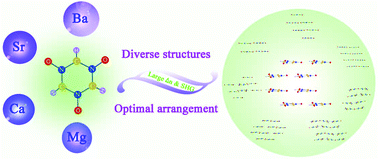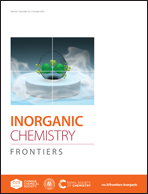Optimal arrangement of π-conjugated anionic groups in hydro-isocyanurates leads to large optical anisotropy and second-harmonic generation effect†
Abstract
Birefringent and nonlinear optical (NLO) crystals play indispensable roles in modern optoelectronics and information communication. Hydro-isocyanurates contain π-conjugated building anions [HxC3N3O3]x−3 (x = 0–3) with strong anisotropic first-order polarizability and large second-order susceptibility, and thus they are proposed as an emerging source of birefringent and NLO crystals. Here, we conducted a systematical exploration of alkaline earth-metal hydro-isocyanurates and successfully obtained eight new compounds: Mg(H2C3N3O3)2·8H2O (I), Mg(H2C3N3O3)2·6H2O (II), Ca(H2C3N3O3)2·3H2O (III), α-Sr(H2C3N3O3)2·2H2O (IV), β-Sr(H2C3N3O3)2·2H2O (V), SrHC3N3O3(VI), SrHC3N3O3·2.5H2O (VII) and Ba(H2C3N3O3)2·2H2O (VIII). Most of them possess larger birefringence (>0.24) than commercial ultraviolet birefringent crystals such as calcite (∼0.16). In particular, among all the reported hydro-isocyanurates, acentric VII exhibits a giant NLO effect (d15 = 5 pm V−1) and desirable birefringence (Δn = 0.341 @ 800 nm) to realize a short phase-matching wavelength, due to the optimal arrangement of anionic groups.



 Please wait while we load your content...
Please wait while we load your content...